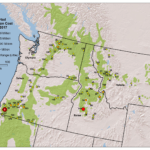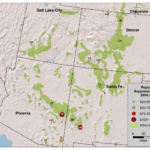This coarse-resolution assessment suggests that much of the West’s wildfire problem traces to the deteriorated condition of its dry ponderosa pine sites.
A peer-reviewed analysis.
By Jerry T. Williams,
Former National Director of Fire & Aviation Management, U.S. Forest Service, Retired
and Matthew H. Panunto.
Ecologist. U.S. Forest Service, Rocky Mountain Research Station Fire Sciences Laboratory
Editor’s Note: This analysis introduces the occasional publication of peer-reviewed analysis papers in Wildfire Magazine.While all articles in Wildfire are reviewed and edited, we often seek the more immediate work of professional practitioners and wildfire journalists. The more formal peer-review process has typically been reserved for science-based journals (such as our sister IAWF publication, the International Journal of Wildland Fire). Yet often a work of analysis is best suited to reach a mix of practitioners, fire researchers and fire managers, who are the readers of Wildfire. To submit an article to Wildfire for peer-review, please visit our Submittable site.
Introduction and Background
In this analysis we introduce a broad-scale long-term overview of the US West’s costliest wildfires in relation to the natural distribution of ponderosa pine (Pinus ponderosa). The species is dependent on frequent, low-intensity burning, but in absence of this function, it has become one of the region’s most altered ecosystems (U.S. Government Accounting Office, 1999; U.S.D.A. Forest Service, 2000; Arno and Allison-Bunnell, 2002; Fiedler and Arno, 2015). This analysis illuminates the relationship between deteriorated forest conditions over very large scales and the potential for severe, high-cost wildfires. Based on this analysis, we argue that the West’s wildfire crisis is fundamentally a forest land management problem and not a fire control failure, as it is more commonly perceived (Williams, 2013).
This analysis also calls for a much-expanded restoration program as a means to establish a more cost-efficient, safer, and more ecologically appropriate wildland fire management strategy in high-risk fire-prone forests.
It has been some 50 years since the first federal wildland fire management agencies began transitioning from a fire control protection model to a fire management protection model (van Wagtendonk, 2007). Concerns for run-away firefighting costs, safety, and ecological damage were the genesis for this change in wildland fire protection policy (Pyne, 1982). In the intervening years, none of these concerns have diminished. In fact, outside of large wilderness areas, where much-expanded fire-use has been restoring natural processes and re-establishing a diverse vegetative mosaic (Teske, et al, 2012), wildfire costs, losses, damages, and dangers have climbed at alarming rates. Since 2000, at least 7 of the 11 western states have suffered their worst wildfires on record (Williams and Hyde, 2009; Williams, 2014). Despite a half-century of movement toward a fire management model, the concept’s goals for reigning in costs, improving margins of safety, and restoring ecological integrity have not been realized.
A number of agency reports, research papers, field studies, staffing documents, and other investigations have observed a relationship between altered forest conditions and the propensity for more severe, stand-replacement wildfires, particularly in the West’s dry forest types (USDA Forest Service, 1995; U.S. Government Accounting Office, 1999; USDA Forest Service, 2000; Pyne, 2004; Fiedler and Arno, 2015; Ferguson, 2017). This paper offers a comprehensive, 18-year long-term assessment that shows a widespread pattern confirming these observations across the eleven Western states. The consistency of this pattern and the costs associated with it might encourage a re-evaluation of our over-reliance on firefighting as the principal means for protection and, instead, examine other options that focus on restoring more resilient forest conditions in fire-adapted, fire-dependent ecosystems.
In the US West, perhaps no fire-adapted forest type has been more thoroughly studied than ponderosa pine. At least three generations of scientists have examined the role of frequent, low-intensity fire in maintaining the health and resilience of these dry-site forests (Leopold, 1928; Weaver, 1943; Biswell et al, 1973; Hall, 1976; Covington et al, 1997; Arno, Smith, and Krebs, 1997; and Fiedler and Arno, 2015). Ironically, many of today’s worst wildfires are occurring in these heavily altered forests that, a century ago, were among the most benign in terms of potential fire severity.
Following more than a century of high-grade logging, livestock grazing, and the virtual elimination of frequent, low-intensity surface burning, these forests are much changed, in terms of species composition, stand structure, density, and fuel loading (Figure 1). In turn, these changes have predisposed broad landscapes to high-intensity stand-replacement wildfires that often remain uncontrollable until firefighters can capitalize on a change in weather or exploit a break in fuels.
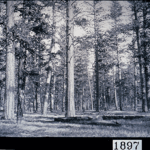
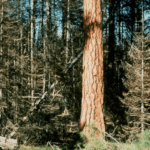
Figure 1: A comparison of a frequent, low intensity fire maintained ponderosa pine forest circa 1897 (top), and a ponderosa pine dominated forest where fire has been long excluded circa 1990s (bottom).
The history, use, ecology, condition, and distribution of the West’s dry ponderosa pine forests have relevance in understanding today’s wildfire problem. Government officials began inventorying and mapping the nation’s forests in the late 1800s. Sargent was among the first in 1884, while subsequent inventories followed in 1897 and 1913 by Mohr and Sudsworth respectively (Little, 1971). These inventories focused on the natural distribution or native range of major tree species. Presence of a particular species was indicated, but abundance or density was not always included. However, early journals and photos from explorers and settlers commonly characterized ponderosa pine forests as open with elevated crowns and grassy understories. The marriage of these early inventories, journals, and photos provides a good idea of the extent and condition of the West’s ponderosa pine forests before early logging, grazing, and fire exclusion began to so profoundly change them.
Fiedler and Arno (2015) estimate that roughly 90% of the West’s ponderosa pine forests have been cut over. Gordon (2014) notes that these forests were heavily exploited and rapidly depleted in the early- to mid-1900’s by timber barons in response to intense demand for lumber, rail ties, mine timbers, and cordwood. Their valley-bottom and foothill sites were easily accessible, hastening their exploitation and removal. During the post-WW II construction boom, old-growth ponderosa pines on higher mountain slopes (also the product of relatively frequent low-intensity fires) were massively harvested, often in large clear-cut logging units. Throughout its range, widespread grazing took out the grasses that once carried low-intensity fire across the forest floor and limited the encroachment of invasive species in ponderosa pine forests. The wholesale elimination of landscape-scale underburning allowed fire-intolerant species to establish and expand their distribution. Ponderosa pine forests that were once described as having 50 or so large trees per acre are, today more commonly described as having upwards of 1,000 spindly ponderosa pine and younger fire-intolerant trees per acre (Gruell et al, 1982; Gruell, 2001). The distribution of ponderosa pine in an open, resilient condition has shrunk to become only a small remnant of its historic extent (Fiedler and Arno, 2015).
Although the look of these forests has changed dramatically over the past 150 years, their site characteristics remain relatively warm and dry; made even drier physiologically as a result of many more trees intercepting and transpiring a lesser quantity of available water. Certainly, the onset of climate change has exacerbated the aridity of these sites (Westerling et al, 2006). Together, these changes go a long way in explaining today’s wildfire problem in the West.
Methods
Wildfire occurrence was collected for the eleven Western states and then overlaid onto the natural distribution of ponderosa pine. A $20 million threshold was established to distinguish high-cost incidents (the $20 million threshold was selected somewhat arbitrarily, based on the approximate cost of an extended twenty-one day-long Incident Management Team assignment on a complex wildfire costing roughly $1 million per day).
The green-shaded area in Figure 2 is from Little (1971), which shows the natural distribution of ponderosa pine in the 11 western states. The graduated symbols displayed in Figure 2 represent the reported latitude/longitude of wildfires with reported suppression costs greater than $20 million.
Incident locations and firefighting costs were derived from information reported in SIT-209’s (NFAM, 2018) and/or National Incident Coordination Center (NICC) Annual Summaries (NIFC, 2018). This assessment used data from 2000, onward (official NICC annual summaries began in 2000). Reported suppression costs are a compilation of all monies expended in fighting the fire during the effort to control or suppress it. They do not break out firefighting costs to protect private or public values at risk, nor do they reflect any judgments on cost-effectiveness. The reported costs are for suppression only; they do not include private property losses, natural resource damages, or other wildfire-related impacts.
Some named wildfires were made up of two or more incidents, managed as a single incident or multiple incidents that eventually burned together. All dollars are those spent in the year of the fire (they do not account for inflation). The authors acknowledge that these summaries or reports sometimes reflect data that are incomplete or inconsistently collected from year-to-year.
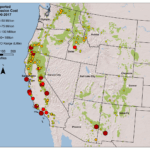
Results and Discussion
This assessment found that, from 2000 and 2017, there have been 187 wildfires having reported suppression costs greater than $20 million in the eleven Western states. Most of these incidents cost much more than $20 million to control. In all, the total suppression costs, alone, exceeded $8 billion for these 187 incidents.
The true, total costs of wildfires go far beyond the suppression costs reported here; they include private property losses, natural resource damages, as well as environmental degradation, human health effects, infrastructure repairs, adverse impacts to local economies, post-fire rehabilitation, and other long-term costs. They are not accounted for in existing summaries and, therefore, remain largely unknown. Two studies indicate that these un-reported costs, losses, and damages may be 5- to 10-times, or more, greater than reported suppression costs alone (WFLC, 2010; Hessburg, 2017). For example, following the disastrous 2017 fire season, the California insurance commissioner subsequently reported that nearly $12 billion had been submitted in wildfire-related property claims alone (California Department of Insurance, 2018).
The 187 incidents burned over 15 million acres (approximately 23,400 square miles). Among the 187 incidents, 116 (62.03%) occurred within the natural distribution of ponderosa pine, as mapped by Little (1971). These 116 incidents burned over 9.7 million acres (64.7% of the total) and cost over $5 billion to control (64.3% of the total).
California had the greatest number of reported high-cost incidents; 97 out of the 187 (52%). Of these 97 incidents, 59 were within Little’s natural range of ponderosa pine (60.82%).
Of the West’s ten wildfires with highest reported suppression costs, seven were located in California, including the 132,000 acre Soberanes Fire (2016), the nation’s most expensive wildfire on record with a reported suppression cost of $262.5 million.
Conclusions
Although very large wildfires typically burn across a variety of forest types, many of them are concentrated in forests that, today, are burning at intensities well beyond those experienced historically. The preponderance of high-intensity, stand-replacement wildfires occurring in ponderosa pine ecosystems is a significant departure from historical patterns. The prevalence of high-cost incidents within the mapped natural distribution of ponderosa pine infers an important pattern: 150-years of change on these sites have predisposed present day forests to most of today’s highest cost wildfires.
Because these forests also tend to occupy valley-bottoms and foothills, where people, property, and other high values are often most concentrated, wildfires in these areas almost always result in high losses and damages. Throughout much of the West, homeowners who locate in wildland-urban interface settings are not required to reduce fuel hazards or comply with Firewise standards (NFPA, 2018) as a requisite for wildfire protection or as an incentive for insurance coverage. Consequently, the protection of private property in these areas typically carry inordinately high costs. Compounding the situation is the fact that protecting private property often occurs at the expense of public values (e.g. damage to watersheds, critical habitat, air quality, others).
In broad terms, the results of this assessment point to a serious and urgent forest land management crisis. In Arizona, alone, between 1990 and 2010, Swetnam (2012) estimated that nearly 20 percent of Arizona’s forests burned over with near-complete mortality. Despite the commonly held view that today’s worst wildfires are considered either “accidents of nature,” a result of poor management decisions, or due to a lack of firefighting effort, this assessment helps support the analysis that much of today’s wildfire problem traces to vulnerable forest conditions on dry sites. In this context, uncharacteristically severe wildfires in these altered forests are among the least natural of the natural disasters that, today, confront those living in the US West.
Nearly two-thirds of all western wildfires with reported suppression costs exceeding $20 million occurred within the natural distribution of ponderosa pine. These wildfires burned almost two-thirds of the total acreage documented in this assessment and accounted for close to two-thirds of the assessment’s reported suppression expenditures. The proportions involved are perhaps a “bad-news – good news” story. The bad news is that these forests, over a century of exploitation and neglect, have devolved into a condition that makes them highly susceptible to severe, high-intensity burning. However, the good news is that their ecology holds the key to their resilience and, in turn, our ability to better protect them and provide for our own safety. At appropriate fire intensities and fire return intervals, and at meaningful scales, ponderosa pine can be maintained in a resilient, sustainable condition. This observation is consistent with the findings of wildland fire scientists stretching back to the late 1920’s.
Next Steps
The high suppression costs, as well as the unaccounted losses and damages reflected in this assessment may change the calculus of how alternative wildfire protection models (including greater investments in fuel hazard mitigation) are evaluated. It is unclear that there exists a threshold where high suppression costs, coupled with high wildfire-related losses and damages, might combine to challenge the efficacy of “staying the course” and prompt a change in the protection strategy for the West’s dry forests (Williams, 2014). Certainly, a more complete accounting of the true and total wildfire costs would better reflect the realities involved and help support a more accurate analysis of future protection options.
The very large size of many incidents described in this analysis is not lost within the scale of Little’s map, but a more detailed, site-specific analysis would better support land management decisions.
Although this paper focuses on the relationship between high-cost wildfires and the natural distribution of altered ponderosa pine forests, an overlay of high-cost wildfire perimeters onto LANDFIRE data (Rollins, 2009) may more precisely frame the relationship between vegetation type, condition, and wildfire potential. An integration of more precise fire and vegetative data may also provide an ecological basis for evaluating wildfire protection options. This understanding will be especially critical in the West’s fire-prone ponderosa pine forests where safe, cost-effective protection depends so much on more resilient conditions.
Acknowledgments
The authors gratefully acknowledge Greg Kennett (President and CEO), Travis Benton, and Mike Hillis from the Ecosystem Research Group, Missoula, Montana in the early stages of this assessment. We also thank Dr. Colin Hardy, Chuck McHugh, and Thomas Dzomba with the Missoula Fire Sciences Laboratory, USDA Forest Service, Missoula, Montana for their support in the compilation of data represented in this report. Thanks also to Dr. Stephen F. Arno (retired wildland fire research forester, Stevensville, Montana), Dr. Thomas Zimmerman (President, International Association of Wildland Fire, Boise, Idaho), Tom Harbour (retired National Director of Fire and Aviation Management, USDA, Forest Service, Mesa, Arizona), Dale N. Bosworth (retired Chief, USDA Forest Service, Missoula, Montana), and Gary Morgan (retired Chief Operating Officer, Bushfire Cooperative Research Centre, Ballarat, Victoria, Australia) for their review of this paper.
The authors take full responsibility for any mistakes or omissions that may have occurred in summarizing the data.
Citations
Arno, Stephen F., H.Y. Smith, and M.A. Krebs, 1997. Old Growth Ponderosa Pine and Western Larch Stand Structures: Influences of Pre-1900 Fires and Fire Exclusion. U.S. Forest Service, Intermountain Research Station, Research Paper 495.
Arno, Stephen F. and S. Allison-Bunnell, 2002. Flames in Our Forest: Disaster or Renewal? Island Press, Washington, D.C..
Biswell, Harold H., H.R.Kallander, R.Komarek, R.J.Vogl, and H. Weaver,1973. Ponderosa Fire Management: A Task Force Evaluation of Controlled Burning in Ponderosa Pine Forests of Central Arizona. Miscellaneous Publication 2. Tall Timbers Research Station, Tallahassee, FL.
California Department of Insurance. Statewide Insured Losses From the October and December 2017 Wildfires. Released January 31, 2018.
Covington, W.W., P.Z. Fule, M.M. Moore, S.C.Hart, T.E.Kolb, J.N. Mast, S.S. Sackett, and M.R. Wagner, 1997. Restoring Ecosystem Health in Ponderosa Pine Forests of the Southwest. Journal of Forestry 95: 23-29.
Ferguson, Gary, 2017. Land on Fire: The New Reality of Wildfire in the West. Timber Press, Portland, Oregon.
Fiedler, Carl E. and S.F. Arno, 2015. Ponderosa: People, Fire, and the West’s Most Iconic Tree. Mountain Press Publishing Company, Missoula, Montana.
Gordon, Greg, 2014. When Money Grew on Trees: A.B. Hammond and the Age of the Timber Baron. Oklahoma Press, Norman, Oklahoma.
Gruell, George E., W. Schmidt, et.al., 1982. Seventy Years of Vegetal Change in a Managed Ponderosa Pine Forest in Western Montana – Implications for Resource Management. USDA Forest Service, Intermountain Research Station, General Technical Report 130, Ogden, Utah.
Gruell, George E., 2001. Fire in Sierra Nevada Forests: A Photographic Interpretation of Ecological Change Since 1849. Mountain Press Publishing Company, Missoula, Montana.
Hall, Frederick C., 1976. Fire and Vegetation in the Blue Mountains: Implications for Land Managers. pp. 155-170 in: Proceedings Tall Timbers Fire Ecology Conference 15. Tall Timbers Research Station, Tallahassee, Florida.
Hessburg, Paul, 2017. Era of Mega-fires: How Do You Want Your Fire? How Do You Want Your Smoke? Multi-media event presentation sponsored by NRFIRESCIENCE.ORG. University of Montana, Missoula, MT, 24 April, 2017.
Leopold, Aldo, 1928. Grass, Brush, Timber, and Fire in Southern Arizona. Journal of Forestry 22 (6): 1-10.
Little, Elbert L., 1971. Atlas of United States Trees, Volume 1. Conifers and Important Hardwoods. USDA Forest Service Miscellaneous Publication No. 1146. Washington, D.C..
National Fire Protection Association (NFPA), 2018. Standard for Reducing Structure Ignition Hazards From Wildland Fire. NFPA 1144, 2018 edition. NFPA, 1 Batterymarch Park, Quincy, MA.
National Interagency Coordination Center (NICC). 2018. Wildland Fire Annual Reports. National Interagency Fire Center. https://www.predictiveservices.nifc.gov/intelligence/intelligence.htm. Accessed on February 8, 2018.
Pyne, Stephen J., 1982. Fire in America: A Cultural History of Wildland and Rural Fire. Princeton University Press, Princeton, NJ.
Pyne, Stephen J., 2004. Tending Fire: Coping with America’s Wildland Fires, 2004. Island Press, Washington, D.C.
Rollins, M.G. 2009. LANDFIRE: a nationally consistent vegetation, wildland fire, and fuel assessment. International Journal of Wildland Fire 18:235-249.
Swetnam, Thomas. Director, Laboratory of Tree-Ring Reserach, University of Arizona. Tucson, Arizona. In personal e-mail exchange with the author (5/12/2012).
Teske, Casey C., C.A. Seielstad, L.P. Queen, 2012. Characterizing Fire-on Fire Interactions in Three Large Wilderness Areas. Fire Ecology Volume 8, Issue 2.
USDA Forest Service Staffing Paper, “Course to the Future,” 1995. On file, Fire & Aviation Management, Washington Office Headquarters USDA Forest Service. Washington, DC.
USDA Forest Service, “Protecting People and Sustaining Resources in Fire-Adapted Ecosystems – A Cohesive Strategy, 2000. Federal Register 65: No. 218 (11/09/2000).
United States General Accounting Office, 1999. Western National Forests: A Cohesive Strategy is Needed to Address Catastrophic Wildfire Threats. GAO/RCED-99-65. April, 1999.
van Wagtendonk, Jan W., 2007. The History and Evolution of Wildland Fire-Use. Fire Ecology Volume 3, Issue 2.
Weaver, Harold H., 1943. Fire as an Ecological and Silvicultural Factor in the Ponderosa Pine Region of the Pacific Slope. Journal of Forestry 41: 7-14.
Westerling, A.L., H.G. Hidaldo, D.R. Cayan, and T.W. Swetnam, 2006. Warming and Earlier Spring Increase in Western U.S. Forest Wildfire Activity. Science Volume 313: 940-943.
Western Fire Leadership Coalition, 2010. The True Cost of Wildfire in the Western U.S. (originally published in April 2009). Western Fire Leadership Coalition, Lakewood, Colorado.
Williams, Jerry T. and A. Hyde, 2009. The Mega-fire Phenomenon: Observations from a Coarse-scale Assessment with Implications for Foresters, Land Managers, and Policy-makers. Presented at the 89th Society of American Forsters National Convention (2 October 2009), Orlando, FL.
Williams, Jerry T., 2013. Exploring the Onset of High-impact Mega-fires Through a Land Management Prism. Forest Ecology and Management 294: 4-10.
Williams, Jerry T., 2014. Between a Rock and a Hard Place: Growing Wildfire Threats and the Urgency to Adapt Protection Strategies. International Association of Wildland Fire and Association for Fire Ecology Conference (May 29-23, 2014, Missoula, MT.). Conference Proceedings.
Appendices
